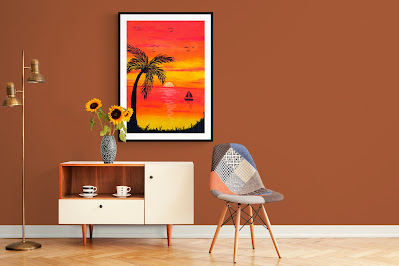So, what exactly is art using Oil Pastels?
Oil Pastel Art Explained
Oil pastels are a medium that combines the qualities of oil paints and soft pastels. They consist of pigments bound in a non-drying oil and wax binder, and are known for their vibrant colors and ability to create textured, painterly effects.
Oil pastels are a versatile medium that can be applied to a variety of surfaces. They are suitable for both studio and plein air painting*,
as they can be used on paper, card, and canvas. To achieve the best
results, it's important to start with a smooth surface and consider
applying a fixative, such as a workable fixative spray, to help set the
pastels and prevent smudging, especially when working on paper.
When using oil pastels, it's important to prepare your paper or
canvas surface by gently sanding it. This creates a "tooth" or rough
surface for the oil pastels to adhere to, allowing for better coverage
and texture. If you're working on paper, it's also helpful to apply a
fixative, such as a workable fixative spray, to help set the pastels and
prevent smudging. You can also purchase textured paper suitable for
Oil Pastels from any Art Store. Saves you having to sand the surface first.
One of the unique characteristics of oil pastels is their ability to be layered. To build up color, start by applying a light layer of pastel and gradually add more layers, blending as you go to create a smooth finish. You can also use a blending tool, such as a finger or blending stick, to soften the edges and blend colors together.
One of the most important things to remember when working with oil
pastels is that they do not completely dry due to the oils in them. This
gives you more time to work with the pastels and make adjustments, but
it also means that you need to be careful not to smudge your work. If
you're working on a large painting, it's a good idea to lay down some
parchment paper for your hand to rest on so that you do not smudge your
work.
In addition to traditional techniques like layering and blending, oil pastels can also be used to create textured effects. Experiment with different techniques like scumbling, cross-hatching, and impasto. Scumbling involves using a dragging motion to apply the pastels, creating a textured, broken-color effect. Cross-hatching involves applying diagonal lines in different directions to create a sense of depth and movement. Impasto involves applying a thick layer of pastels to create a three-dimensional effect.
Oil pastels are also suitable for the artist to be used in mixed-media. They can be combined with other mediums like pencil, watercolor, and acrylic to create a unique and personal expression in the work. Oil pastels can also be used to create under painting for a final oil painting.
In conclusion, oil pastels are a unique medium that offers a wide range of possibilities for the artist. Whether you're a beginner or a seasoned painter, oil pastels offer a way to create vibrant, textured, and painterly effects in your work. With their versatility and ability to be layered, oil pastels provide a unique and exciting opportunity to explore different techniques and styles in your art.
* What is Plein Air Painting?
Plein air painting is the practice of painting outdoors in natural light. The term "plein air" comes from the French phrase "en plein air," which means "in the open air." This style of painting became popular in the late 19th century as artists sought to capture the beauty of the natural landscape.
Plein air paintings are typically done on location, rather than in a studio. Artists take their materials, such as canvas, paints, and brushes, out into the landscape and set up their equipment to begin working. This allows them to work directly from life, capturing the effects of light and the changing weather conditions.
Plein air painting can be done in a variety of environments, from urban to rural settings, and can be done in any type of weather. The goal is to capture the feeling and the atmosphere of the place, using the light and color of the location to create a sense of depth and movement.
Artists often choose to paint plein air because of the challenge and freedom it offers. Painting outside offers new challenges as the light changes and weather conditions fluctuate, but also allows for more freedom of movement and experimentation, especially when compared to studio painting.
This is one reason why oil pastels are a great medium for plein air painting. Oil pastels are easy to carry around, easy to work with on location, and because they don't dry out quickly, they allow the artist to take their time and make adjustments as they paint.
More examples of my art below -








No comments:
Post a Comment